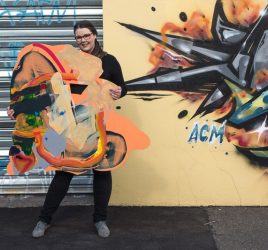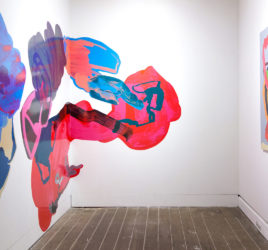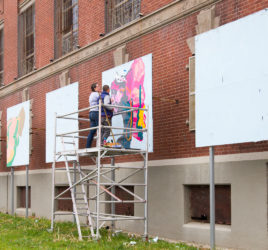Donald Judd sure did have some nasty things to say about painting. Of course, it wasn’t personal, I know – he wrote the essay Specific Objects during the sixties when I wasn’t even a twinkle. But a painter can become a bit defensive when you say stuff like “the composition must react to the edges [of the canvas] and the rectangle must be unified”! Judd believed that there are only so many compositions possible on the flat rectangle of a canvas, he preferred the boundless dimensions available with scultpure, Judd’s medium of choice. In short, Judd thought painting was just so done. I agree that painting on a canvas can feel limiting. You must obey the rectangle! Obey!
The pressure to obey may be immense but I rebelled. Through a series of realisations, I broke up with the canvas. I remember one day at art school, knocking on the office door of my lecturer after making 3 paintings on wooden board in quick succession. “Is this just what I do now? Do I just keep buying board and painting stuff on it, forever and ever?” As soon as it was out of my mouth, it sounded foolish. I recall grunting and walking away before my lecturer had much time to respond. Though poorly considered at that point, what I was getting at was valid – for me at least. I had come to find the rectangle limiting. Paint this way inside a rectangle, then paint it that way inside a rectangle, repeat ad nauseum. It didn’t make sense somehow.
The Breakup
Painting directly onto the wall improved my prospects for avoiding the edge of the canvas. At least the edges of my wall-canvas were too far away to worry about. When I did arrive at the wall’s edges, I began crossing its line and painting around the corner in disobedience. Now the painting-beast was both 2D and 3D and I noticed it was more human-sized. Instead of a kind of portal through which to look an artwork from the outside, I was now standing inside the artwork moving around inside it.
![Andy Warhol (American, 1928-1987) Cow Wallpaper [Pink on Yellow], 1966 screen print on wallpaper Image (each): 46 x 28 in. (116.8 x 71.1 cm.) The Andy Warhol Museum, Pittsburgh © The Andy Warhol Foundation for the Visual Arts, Inc. Read more at warhol.org: http://www.warhol.org/ArtCollections.aspx?id=1731#ixzz3omWTGLJl](/wp-content/uploads/2015/10/CowWallpaper.jpg)
Cow Wallpaper [Pink on Yellow], 1966 – Andy Warhol
Screen print on wallpaper
© The Andy Warhol Foundation for the Visual Arts, Inc
In Andy Warhol’s exhibition at Leo Castelli gallery in the 1960s, he got tongues wagging about this portal vs moving around idea. He rejected the art object (by that I mean a frame, canvas, rectangle – object) and covered the walls of a room in yellow wallpaper covered in bright pink cows staring with goofy-blank cow expressions. Instead of an object that could be held with the hands, instead of being the outside observer looking into a portal-painting, the viewer became its centre. As an artwork that is human-sized and enveloping – I can work with that.
For some time now I’ve been camping out on this idea – when I paint in large swathes onto vinyl I’m mobile, I have a physical interaction with a painting at a scale that works for my long limbs. I hope others sense that movement too, that in order to see the work you have to move around, look at it from different vantage points, step over it. Off the canvas and on the floor, turning corners and going up walls, the work isn’t complete until it’s been seen. If you want to see it you’ll have to move!
See for yourself.



